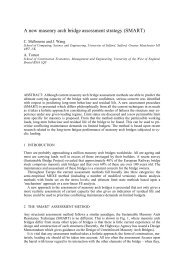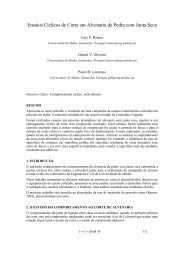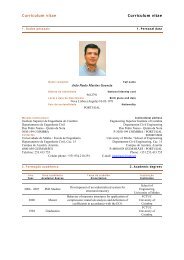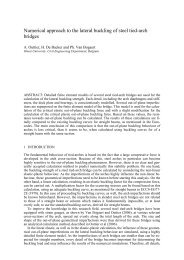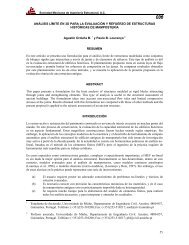an orthotropic continuum model for the analysis of masonry structures
an orthotropic continuum model for the analysis of masonry structures
an orthotropic continuum model for the analysis of masonry structures
You also want an ePaper? Increase the reach of your titles
YUMPU automatically turns print PDFs into web optimized ePapers that Google loves.
TNO-95-NM-R0712 1995 33The expl<strong>an</strong>ation <strong>for</strong> <strong>the</strong> over prediction <strong>of</strong> <strong>the</strong> failure load will now be detailed. Fig. 25a shows that<strong>the</strong> experimental load-displacement diagram is well reproduced until a horizontal displacement dequal to 1.0 mm, which coincides with <strong>the</strong> opening <strong>of</strong> <strong>the</strong> diagonal shear crack. After this point, itseems that <strong>the</strong> behaviour <strong>of</strong> <strong>the</strong> structure is not captured by <strong>the</strong> <strong>model</strong>. The crucial question iswhe<strong>the</strong>r <strong>the</strong> <strong>masonry</strong> macro-<strong>model</strong> here proposed is not acceptable or <strong>the</strong> <strong>model</strong>ling strategy isinadequate. The author believes <strong>the</strong> latter to be true.Fig. 24 clearly shows <strong>an</strong> extremely localized diagonal failure type in which all inelastic phenomenaconcentrate, basically, in a single stepped crack. A complete underst<strong>an</strong>ding <strong>of</strong> <strong>the</strong> behaviour <strong>of</strong> <strong>the</strong>structure is obtained by <strong>the</strong> distribution <strong>of</strong> internal <strong>for</strong>ces calculated by <strong>the</strong> micro-<strong>model</strong>, see Fig.33. Fig. 33a shows that, initially, <strong>the</strong> direction <strong>of</strong> <strong>the</strong> compressive strut is determined by <strong>the</strong> geometry<strong>of</strong> <strong>the</strong> bricks <strong>an</strong>d deviates from <strong>the</strong> strut direction found in <strong>the</strong> macro-<strong>an</strong>alysis. The discrep<strong>an</strong>cybetween <strong>the</strong> micro- <strong>an</strong>d macro-<strong>model</strong> gets only larger under increasing de<strong>for</strong>mation. Fig. 33bshows that in reality two independent struts occur once <strong>the</strong> diagonal crack is fully open <strong>an</strong>d a welldeÞned b<strong>an</strong>d completely unloads, with approximately <strong>the</strong> width <strong>of</strong> a brick at <strong>the</strong> center <strong>of</strong> <strong>the</strong> specimen.This phenomenon c<strong>an</strong>not be captured by a (smeared) macro-<strong>model</strong> unless some internallength scale, that reßects <strong>the</strong> <strong>masonry</strong> micro-structure, is incorporated in <strong>the</strong> <strong>model</strong>. This problemis outside <strong>the</strong> scope <strong>of</strong> <strong>the</strong> present report <strong>an</strong>d, presently, no simple solution is envisaged. It is notedthat <strong>the</strong> task is quite complex because it is not clear yet if <strong>the</strong> above length scale is a geometricalproperty dependent on <strong>the</strong> unit size or a structural property that depends on <strong>the</strong> micro-structure,geometry <strong>of</strong> <strong>the</strong> structure <strong>an</strong>d loading conditions.a) d = 1.0 mm d) d = 4.0 mmFig. 33 - Minimum principal stresses <strong>for</strong> a horizontal displacement d obtained by a micro-<strong>model</strong>Louren•o (1994)For <strong>the</strong> sake <strong>of</strong> completeness a new <strong>an</strong>alysis is carried out with <strong>the</strong> macro-<strong>model</strong> <strong>for</strong>mulated insuch a way that degradation <strong>of</strong> tensile strength induces degradation <strong>of</strong> compressive strength, i.e. acoupled <strong>model</strong>. Coupling is introduced via <strong>an</strong> equation <strong>of</strong> <strong>the</strong> following type:


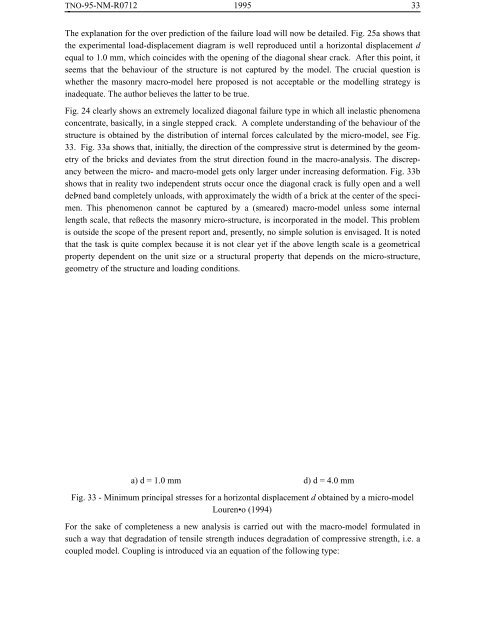
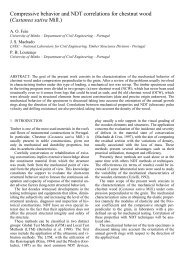
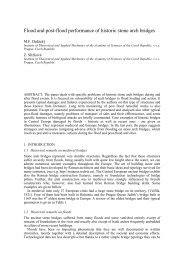
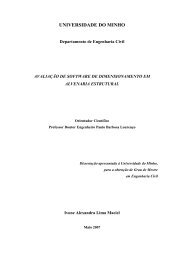

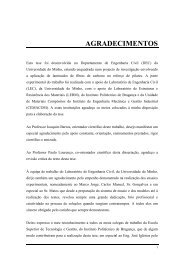

![Weibull [Compatibility Mode]](https://img.yumpu.com/48296360/1/190x134/weibull-compatibility-mode.jpg?quality=85)

